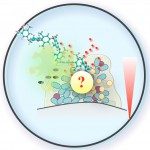Lien vers Pubmed [PMID] – 17981982
J. Bacteriol. 2008 Jan;190(1):264-74
Biofilms are structured communities characterized by distinctive gene expression patterns and profound physiological changes compared to those of planktonic cultures. Here, we show that many gram-negative bacterial biofilms secrete high levels of a small-molecular-weight compound, which inhibits the growth of only Escherichia coli K-12 and a rare few other natural isolates. We demonstrate both genetically and biochemically that this molecule is the amino acid valine, and we provide evidence that valine production within biofilms results from metabolic changes occurring within high-density biofilm communities when carbon sources are not limiting. This finding identifies a natural environment in which bacteria can encounter high amounts of valine, and we propose that in-biofilm valine secretion may be the long-sought reason for widespread but unexplained valine resistance found in most enterobacteria. Our results experimentally validate the postulated production of metabolites that is characteristic of the conditions associated with some biofilm environments. The identification of such molecules may lead to new approaches for biofilm monitoring and control.


